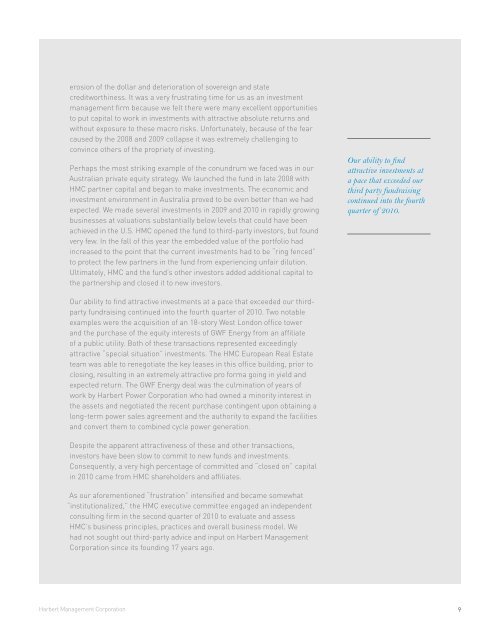2010 Annual Report - Harbert Management Corporation
2010 Annual Report - Harbert Management Corporation
2010 Annual Report - Harbert Management Corporation
Create successful ePaper yourself
Turn your PDF publications into a flip-book with our unique Google optimized e-Paper software.
erosion of the dollar and deterioration of sovereign and state<br />
creditworthiness. It was a very frustrating time for us as an investment<br />
management firm because we felt there were many excellent opportunities<br />
to put capital to work in investments with attractive absolute returns and<br />
without exposure to these macro risks. Unfortunately, because of the fear<br />
caused by the 2008 and 2009 collapse it was extremely challenging to<br />
convince others of the propriety of investing.<br />
Perhaps the most striking example of the conundrum we faced was in our<br />
Australian private equity strategy. We launched the fund in late 2008 with<br />
HMC partner capital and began to make investments. The economic and<br />
investment environment in Australia proved to be even better than we had<br />
expected. We made several investments in 2009 and <strong>2010</strong> in rapidly growing<br />
businesses at valuations substantially below levels that could have been<br />
achieved in the U.S. HMC opened the fund to third-party investors, but found<br />
very few. In the fall of this year the embedded value of the portfolio had<br />
increased to the point that the current investments had to be “ring fenced”<br />
to protect the few partners in the fund from experiencing unfair dilution.<br />
Ultimately, HMC and the fund’s other investors added additional capital to<br />
the partnership and closed it to new investors.<br />
Our ability to find attractive investments at a pace that exceeded our thirdparty<br />
fundraising continued into the fourth quarter of <strong>2010</strong>. Two notable<br />
examples were the acquisition of an 18-story West London office tower<br />
and the purchase of the equity interests of GWF Energy from an affiliate<br />
of a public utility. Both of these transactions represented exceedingly<br />
attractive “special situation” investments. The HMC European Real Estate<br />
team was able to renegotiate the key leases in this office building, prior to<br />
closing, resulting in an extremely attractive pro forma going in yield and<br />
expected return. The GWF Energy deal was the culmination of years of<br />
work by <strong>Harbert</strong> Power <strong>Corporation</strong> who had owned a minority interest in<br />
the assets and negotiated the recent purchase contingent upon obtaining a<br />
long-term power sales agreement and the authority to expand the facilities<br />
and convert them to combined cycle power generation.<br />
Despite the apparent attractiveness of these and other transactions,<br />
investors have been slow to commit to new funds and investments.<br />
Consequently, a very high percentage of committed and “closed on” capital<br />
in <strong>2010</strong> came from HMC shareholders and affiliates.<br />
As our aforementioned “frustration” intensified and became somewhat<br />
“institutionalized,” the HMC executive committee engaged an independent<br />
consulting firm in the second quarter of <strong>2010</strong> to evaluate and assess<br />
HMC’s business principles, practices and overall business model. We<br />
had not sought out third-party advice and input on <strong>Harbert</strong> <strong>Management</strong><br />
<strong>Corporation</strong> since its founding 17 years ago.<br />
<strong>Harbert</strong> <strong>Management</strong> <strong>Corporation</strong><br />
Our ability to find<br />
attractive investments at<br />
a pace that exceeded our<br />
third party fundraising<br />
continued into the fourth<br />
quarter of <strong>2010</strong>.<br />
9




